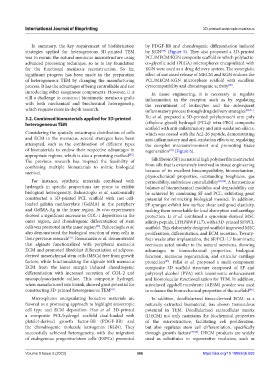Page 374 - IJB-9-3
P. 374
International Journal of Bioprinting 3D-printed anistropic meniscus
In summary, the key requirement of biofabrication by PDGF-BB and chondrogenic differentiation induced
strategies applied for heterogeneous 3D-printed TEM by KGN (Figure 5). They also proposed a 3D-printed
[88]
was to mimic the natural meniscus microstructure using PCL/MECM/KGN composite scaffold in which polylactic-
advanced processing technique, so as to lay foundation co-glycolic acid (PLGA) microspheres encapsulated with
for the functional meniscus reconstruction. So far, KGN were used as a drug delivery system. The synergistic
significant progress has been made in the preparation effect of sustained release of MECM and KGN endows the
of heterogeneous TEM by changing the manufacturing PCL/MECM-KGN microsphere scaffold with excellent
process. It has the advantages of being controllable and not cytocompatibility and chondrogenic activity .
[89]
introducing other exogenous components. However, it is In tissue engineering, it is necessary to regulate
still a challenge to construct biomimetic meniscus grafts inflammation in the receptor, such as by regulating
with both mechanical and biochemical heterogeneity, the recruitment of leukocytes and the subsequent
which requires more in-depth research. inflammatory process through drug delivery strategies [90,91] .
3.2. Combined biomaterials applied for 3D-printed Xu et al. prepared a 3D-printed polylactone/4 arm poly
heterogeneous TEM (ethylene glycol) hydrogel (PCL@ tetra-PEG) composite
scaffold with anti-inflammatory and anti-oxidation effects,
Considering the spatially anisotropic distribution of cells which was coated with the Ac2-26 peptide, demonstrating
and ECM in the meniscus, several strategies have been anti-inflammatory and anti-oxidation effects on regulating
attempted, such as the combination of different types the complex microenvironment and promoting tissue
of biomaterials to endow their respective advantages in regeneration (Figure 6).
[92]
appropriate regions, which is also a promising method .
[85]
The previous research has inspired the feasibility of Silk fibroin (SF) is a natural high polymer fibrin extracted
combining multiple biomaterials to mimic biological from silk that is extensively involved in tissue engineering
menisci. because of its excellent biocompatibility, biomechanism,
physiochemical properties, outstanding toughness, gas
For instance, synthetic materials combined with permeability, and release controllability [93,94] . A harmonious
hydrogels in specific proportions are prone to exhibit balance of biomechanical modulus and degradability can
biological heterogeneity. Bahcecioglu et al. anatomically be achieved by combining SF and PCL, exhibiting great
constructed a 3D-printed PCL scaffold with cast cell- potential for mimicking biological menisci. In addition,
loaded gelatin methacrylate (GelMA) in the periphery SF sponges exhibit low surface shear and good elasticity,
and GelMA-Ag in the inner region. In vivo experiments making them remarkable for load absorption and cartilage
showed a significant increase in COL-1 deposition in the protection. Li et al. combined a synovium-derived MSC
outer region, and chondrogenic differentiation of stem affinity peptide, LTHPRWP (L7), with a 3D-printed SF/PCL
cells was promoted in the inner region . Bahcecioglu et al. scaffold. This elaborately designed scaffold improved MSC
[86]
also demonstrated the biological reaction of stem cells in proliferation, differentiation, and ECM secretion. Twenty-
their previous research . Romanazzo et al. demonstrated four weeks after implantation, the SF/PCL-L7 biomimetic
[75]
that alginate functionalized with peripheral meniscus meniscus acted similar to the natural meniscus, showing
ECM and promoted fibroblast differentiation of adipose- advantages in biomechanical properties, biological
derived mesenchymal stem cells (MSCs) free from growth function, meniscus regeneration, and articular cartilage
factors, while functionalizing the alginate with meniscus protection . Pillai et al. proposed a multi-component
[95]
ECM from the inner margin induced chondrogenic composite 3D scaffold structure composed of SF and
differentiation with increased secretion of COL-2 and polyvinyl alcohol (PVA) with biomimetic enhancement
mucopolysaccharide sulfate. This composite hydrogel, and biomolecular functionalization for TEM. In addition,
when manufactured into bioink, showed great potential for autoclaved eggshell membrane (AESM) powder was used
constructing 3D-printed heterogeneous TEM . to enhance the biomechanical properties of the scaffold .
[87]
[96]
Microspheres encapsulating bioactive materials are In addition, decellularized tissue-derived ECM, as a
favored as a promising approach to highlight anisotropic naturally extracted biomaterial, has shown tremendous
cell type and ECM deposition. Hao et al. 3D-printed potential in TEM. Decellularized extracellular matrix
a composite PCL/hydrogel scaffold dual-loaded with (DECM) not only maintains the biochemical properties
platelet-derived growth factor-BB (PDGF-BB) and of the microstructure, facilitating cell proliferation,
the chondrogenic molecule kartogenin (KGN). They but also regulates stem cell differentiation, specifically
successfully achieved heterogeneity, with the migration through growth factors [97,98] . DECM products are widely
of endogenous progenitor/stem cells (ESPCs) promoted used as substitutes in regenerative medicine, such as
Volume 9 Issue 3 (2023) 366 https://doi.org/10.18063/ijb.693

